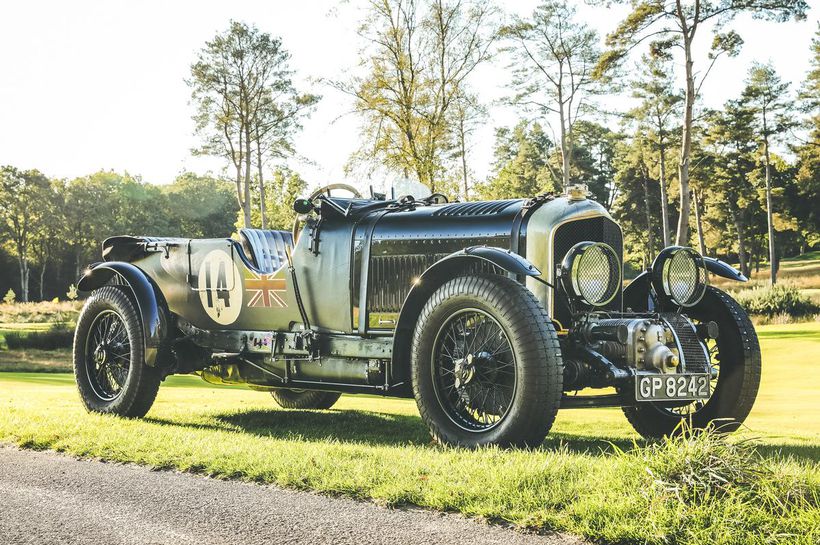
The Bentley 4½ Litre is a British car based on a rolling chassis built by Bentley Motors. Walter Owen Bentley replaced the Bentley 3 Litre with a more powerful car by increasing its engine displacement to 4.4 litres (270 cubic inches). A racing variant was known as the Blower Bentley.
Bentley buyers used their cars for personal transport and arranged for their new chassis to be fitted with various body styles, mostly saloons or tourers. However, the publicity brought by their competition programme was invaluable for marketing Bentley's cars.
At the time, noted car manufacturers such as Bugatti and Lorraine-Dietrich focused on designing cars to compete in the 24 Hours of Le Mans, a popular automotive endurance course established only a few years earlier. A victory in this competition quickly elevated any car maker's reputation.
A total of 720 4½ Litre cars were produced between 1927 and 1931, including 55 cars with a supercharged engine popularly known as the Blower Bentley. A 4½ Litre Bentley won the 24 Hours of Le Mans in 1928. Though the supercharged 4½ Litre Bentley's competitive performance was not outstanding, it set several speed records, most famously the Bentley Blower No.1 Monoposto in 1932 at Brooklands with a recorded speed of 222.03 km/h (138 mph).
Bentley at the 24 Hours of Le Mans
The 24 Hours of Le Mans endurance race is a 24-hour race around the Circuit de la Sarthe. The inaugural race was held 26–27 May 1923, and attracted many drivers, mostly French. There were two foreign competitors in the first race, Frank Clement and Canadian John Duff, the latter winning the 1924 competition in his personal car, a Bentley 3 Litre.
"Made with precision and the finest material," and with recent success, the luxurious Bentley cars attracted attention. After two years without success, Bentley convened a group of wealthy British men, "united by their love of insouciance, elegant tailoring, and a need for speed," to renew Bentley's success. Both drivers and mechanics, these men, later nicknamed the "Bentley Boys", drove Bentley automobiles to victory in several races between 1927 and 1931, including four consecutive wins at the 24 Hours of Le Mans, and forged the brand's reputation.
It was within this context that, in 1927, Bentley developed the Bentley 4½ Litre. Two cylinders were removed from the 6½ Litre model, reducing the displacement to 4.4 litres. At the time, the 3 Litre and the 6½ Litre were already available, but the 3 Litre was an outdated, under-powered model and the 6½ Litre's image was tarnished by poor tyre performance.
Sir Henry "Tim" Birkin, described as "the greatest British driver of his day" by W. O. Bentley, was one of the Bentley Boys. He refused to adhere strictly to Bentley's assertion that increasing displacement is always preferable to forced induction. Birkin, aided by a former Bentley mechanic, decided to produce a series of five supercharged models for the competition at the 24 Hours of Le Mans; Mercedes-Benz had been using superchargers for years.
Thus the 4½ litre Blower Bentley was born. The first supercharged Bentley had been a 3-litre FR5189 which had been supercharged at the Cricklewood factory in the winter of 1926/7. The Bentley Blower No.1 was officially presented in 1929 at the British International Motor Show at Olympia, London. The 55 copies were built to comply with 24 Hours of Le Mans regulations. Birkin arranged for the construction of the supercharged cars having received approval from Bentley chairman and majority shareholder Woolf Barnato and financing from wealthy horse racing enthusiast Dorothy Paget. Development and construction of the supercharged Bentleys was done in a workshop in Welwyn Garden City by Amherst Villiers, who also provided the superchargers.
W.O. Bentley was hostile to forced induction and believed that "to supercharge a Bentley engine was to pervert its design and corrupt its performance." However, having lost control of the company he founded to Barnato, he could not halt Birkin's project.
Blower Bentley
The essential difference between the Bentley 4½ Litre and the Blower was the addition of a Roots-type supercharger to the Blower engine by engineer Amherst Villiers, who had also produced the supercharger. W. O. Bentley, as chief engineer of the company he had founded, refused to allow the engine to be modified to incorporate the supercharger. As a result, the supercharger was placed at the end of the crankshaft, in front of the radiator. This gave the Blower Bentley an easily recognisable appearance and also increased the car's understeer due to the additional weight at the front. A guard protected the two carburetters located at the compressor intake. Similar protection was used, both in the 4½ Litre and the Blower, for the fuel tank at the rear, because a flying stone punctured the 3 Litre of Frank Clement and John Duff during the first 24 Hours of Le Mans, which contributed to their defeat.
The crankshaft, pistons and lubrication system were special to the Blower engine. It produced 175 hp (130 kW) at 3,500 rpm for the touring model and 240 hp (180 kW) at 4,200 rpm for the racing version, which was more power than the Bentley 6½ Litre developed.
In 2019–2020, Bentley scanned all 630 components that made up the Blower so that they could digitally re-create it and create 12 new models. In December 2020, Bentley Blower Car Zero, the first example of the Blower Continuation Series was presented. The car was built in Crewe according to the historic specifications and based on the production processes of that period.



































































